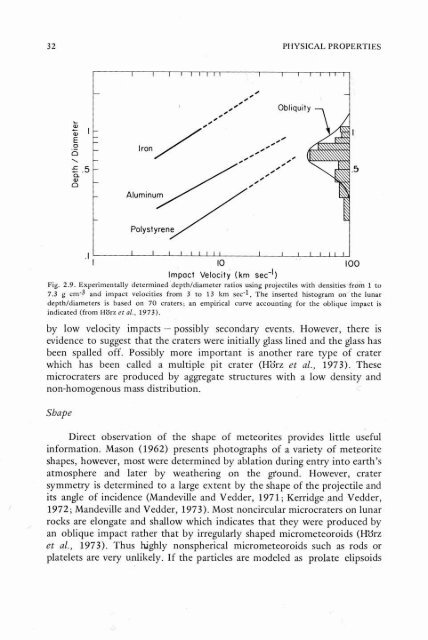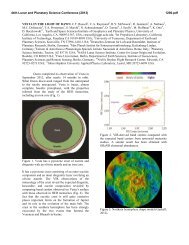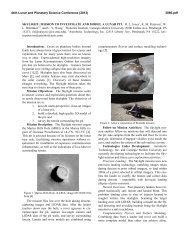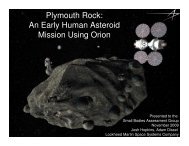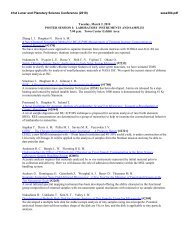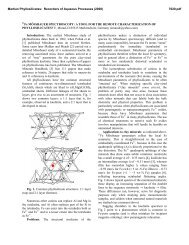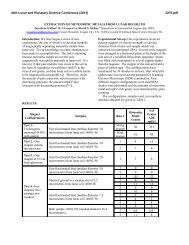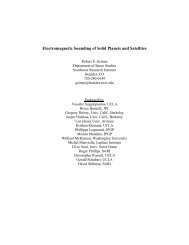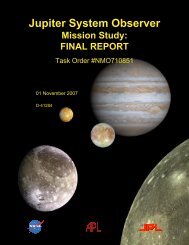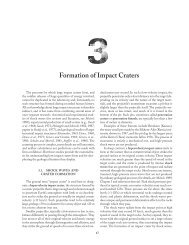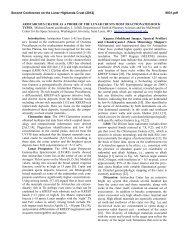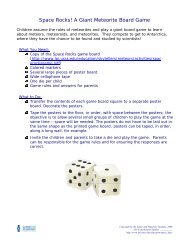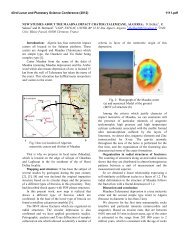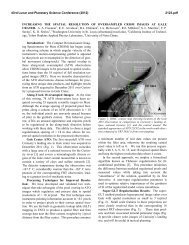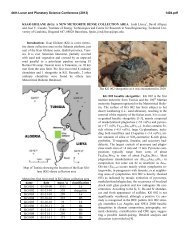Chapter 2: Energy at the Lunar Surface - Lunar and Planetary Institute
Chapter 2: Energy at the Lunar Surface - Lunar and Planetary Institute
Chapter 2: Energy at the Lunar Surface - Lunar and Planetary Institute
Create successful ePaper yourself
Turn your PDF publications into a flip-book with our unique Google optimized e-Paper software.
PHYSICAL PROPERTIES<br />
I I I r 1 1 1 1 1 I I 1 1 1 1 1 1<br />
I 10 100<br />
Impact Velocity (km sec-I)<br />
Fig. 2.9. Experimentally determined depth/diameter r<strong>at</strong>ios using projectiles with densities from 1 to<br />
7.3 g cm73 <strong>and</strong> impact velocities from 3 to 13 km sec-l. The inserted histogram on'<strong>the</strong> lunar<br />
depth/diameters is based on 70 cr<strong>at</strong>ers; an empirical curve accounting for <strong>the</strong> oblique impact is<br />
indic<strong>at</strong>ed (from H'drz et al., 1973).<br />
by low velocity impacts - possibly secondary events. However, <strong>the</strong>re is<br />
evidence to suggest th<strong>at</strong> <strong>the</strong> cr<strong>at</strong>ers were initially glass lined <strong>and</strong> <strong>the</strong> glass has<br />
been spalled off. Possibly more important is ano<strong>the</strong>r rare type of cr<strong>at</strong>er<br />
which has been called a multiple pit cr<strong>at</strong>er (Hb'rz et al., 1973). These<br />
microcr<strong>at</strong>ers are produced by aggreg<strong>at</strong>e structures with a low density <strong>and</strong><br />
non-homogenous mass distribution.<br />
Shape<br />
Direct observ<strong>at</strong>ion of <strong>the</strong> shape of meteorites provides little useful<br />
inform<strong>at</strong>ion. Mason (1962) presents photographs of a variety of meteorite<br />
shapes, however, most were determined by abl<strong>at</strong>ion during entry into earth's<br />
<strong>at</strong>mosphere <strong>and</strong> l<strong>at</strong>er by we<strong>at</strong>hering on <strong>the</strong> gfound. However, cr<strong>at</strong>er<br />
symmetry is determined to a large extent by <strong>the</strong> shape of <strong>the</strong> projectile <strong>and</strong><br />
its angle of incidence (M<strong>and</strong>eville <strong>and</strong> Vedder, 1971 ; Kerridge <strong>and</strong> Vedder,<br />
1972; M<strong>and</strong>eville <strong>and</strong> Vedder, 1973). Most noncircular microcr<strong>at</strong>ers on lunar<br />
rocks are elong<strong>at</strong>e <strong>and</strong> shallow which indic<strong>at</strong>es th<strong>at</strong> <strong>the</strong>y were produced by<br />
an oblique impact r<strong>at</strong>her th<strong>at</strong> by irregularly shaped micrometeoroids (Wdrz<br />
et al., 1973). Thus highly nonspherical micrometeoroids such as rods or<br />
pl<strong>at</strong>elets are very unlikely. If <strong>the</strong> particles are modeled as prol<strong>at</strong>e elipsoids


